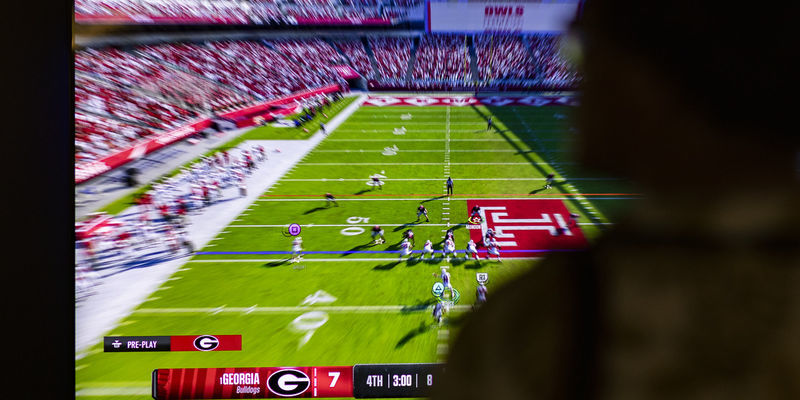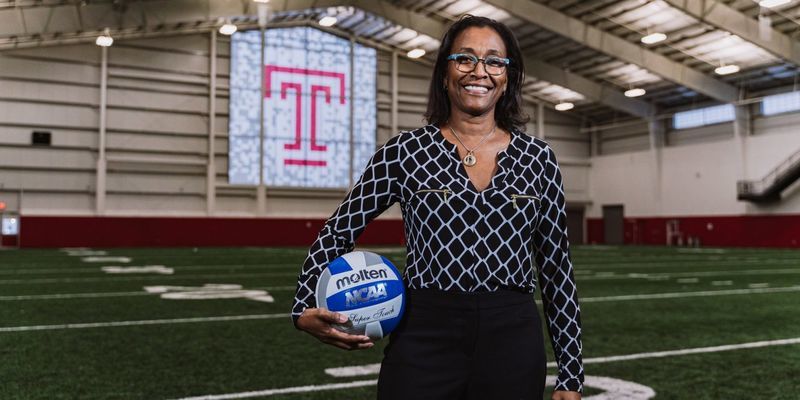Ahead of the playoffs, experts discuss the WNBA and Caitlin Clark
The WNBA has exploded in popularity in recent years. A few of Temple’s distinguished faculty members share their insight into why this has happened and what to expect in the future.

Since its founding in 1996, the WNBA has fought against other sports for the spotlight. In more recent years, the league has expanded in popularity, with star players such as Caitlin Clark and Angel Reese becoming household names, and fans and experts believe its influence will only continue to grow.
As the playoffs get ready to tip off on Sunday, Sept. 22, we spoke with three Temple faculty: Lauren Bullock, assistant professor of public relations at Klein College of Media and Communication; Elizabeth Taylor, assistant professor of sports studies in the School of Sport, Tourism and Hospitality Management; and Michael Leeds, professor of sports economics in the College of Liberal Arts, about the pay gap between the WNBA and NBA, the WNBA’s legacy of political activism, and how the league can continue to increase in popularity in the future.
Why is the WNBA so popular now?
Bullock: “We’re looking at almost three decades of professional women’s basketball in the United States. We’re starting to see more of the population interested in sports, including professional women’s basketball. And a lot of girls have professional athletes as role models that they can connect to because they see similarities. But also, the quality of the league is getting better. There was always quality but now it’s more widespread; there’s depth on college rosters and more opportunities on professional rosters. The WNBA is becoming more popular because of those factors and the timing of this being almost its third decade (in existence). It’s the perfect storm.”
Taylor: “This rise in popularity of women’s sports isn’t just specific to the WNBA. And I think that’s important, because we’ve been having this conversation for a while. It’s kind of like a chicken or the egg: Did we need the fans so that we could get more women’s competitions on TV and more support in terms of funding, or vice versa? But we know that participation rates for girls and women are skyrocketing. A lot of folks who have been longtime supporters of women’s sports and who research women’s sports have been saying that the fan base is there but you have to make it accessible. You can’t be putting these competitions on TV on some random network at a really awful time and expect that viewership is going to be there. So I think the recent investment in terms of funding for leagues from investors really provides more opportunities for women.”
Why is the salary gap between WNBA and NBA players a big deal?
Leeds: “I think that’s going to be a big issue. The players, to the degree that the league grows, are going to be agitating for a bigger share of the pie. It’s one thing when you have teams that are just struggling to survive but it’s another when the league is prospering. When do you cross that divide? When do the players come in for a bigger pay day? That’s going to be an interesting thing to watch.”
Taylor: “One of the biggest arguments that folks make for increased salaries in the WNBA is that they want a model of revenue usage that operates similarly to the NBA. If you look at the percentage of NBA revenues that go to player salaries versus the percentage of WNBA revenues that go toward player salaries, there’s a huge discrepancy there. Ticket sales are a huge way that these teams make money. They’re maxing out venues right now. They can’t sell any more tickets. But there’s a cap on their revenue because of some of the factors that are in place with things like TV deals that have been negotiated, the venues that they’re playing in and that sort of thing.”
What do you think about the WNBA's rich history of activism?
Taylor: “The WNBA doesn’t necessarily have the same privileges that a lot of men’s professional athletes have in terms of the ability to turn a blind eye to social injustice. WNBA athletes are directly impacted by so many things that are happening in terms of gender inequality and racism. A lot of the best players in the WNBA are Black women. Some of them are in states that are putting very restrictive bans on women’s healthcare and women’s access to things like birth control and life-saving abortions. In a lot of ways, they don’t have the same privileges that men’s professional athletes do. They’re choosing to recognize that, in addition to being great athletes and providing entertainment to fans, they also have a duty to use their platform to serve a higher good.”
Leeds: “As the WNBA becomes more popular there's going to be pressure on the players—implicit as well as explicit pressure—to tone down any kind of activism because it’s upsetting to people. And when there’s real money at stake investors are going to want players to think twice about saying something that’s going to shut off that money faucet.”
Is the rivalry between Angel Reese and Caitlin Clark good for the WNBA?
Bullock: “True basketball fans are people who are there to actually watch basketball, appreciate the rivalry and see it for what it is. I wonder how Caitlin is being coached on this conversation. I truly believe she wants to just go out there and play basketball. I also wonder whether she understands the weight of her presence as a leader and how to navigate that.”
Leeds: “You have Caitlin Clark and Angel Reese and this rivalry that seems to be budding between the two of them. Nothing helps a sport so much as someone to hate. You wouldn’t be a rabid Michigan fan if there wasn’t Ohio State to hate. You wouldn’t be a rabid UNC fan if there wasn’t Duke to hate. And so, having a foil, whether you’re rooting for Chicago Sky or Indiana Fever, is a good thing. Having that villain is always a good thing.”
Taylor: “I do really love the rivalry that they created throughout their college career and how that has followed them into the WNBA. I think as long as we can create accurate narratives of what’s happening, it’s good for the league. I think the passion is good. I think it creates great marketing opportunities.”
How are NIL deals impacting the WNBA?
Taylor: “Having the opportunity to start earning revenue as a college athlete allows these women to be more successful in their professional career because they’re not starting from scratch. They have the opportunity to engage in these relationships before they enter the league and so they kind of have a better handle on negotiation and social media and things like that. I think the passing of NIL has just allowed women athletes to essentially get a jump-start on any sort of endorsements or partnerships that they would have at the pro level while they’re still in college. I think it benefits the WNBA and allows women to earn more revenue while they’re playing.”
Bullock: “NIL deals are allowing WNBA athletes to get practice at managing their brands earlier than they had in the past. That practice is making them smarter businesswomen because they’re not just taking the first contract offered to them. They’re really looking at it through the lens of, ‘What’s best for my brand? How is this going to affect me financially?’”
What does the future of the WNBA look like?
Leeds: “The worry is that the WNBA will try to do too much too fast and that they will get ahead of themselves. With Caitlin Clark, all indications show she’s going to be a really good player but how that plays out is still yet to be fully determined. The last thing you want is for the weight of the league on her shoulders and for her to not be able to handle that.”
Taylor: “I think it’s important to recognize how young the WNBA is in comparison to the NBA. If you compare the finances of the NBA at the same stage as the WNBA, you see a lot more parity than I think people would like to admit between the two leagues. There was a continued investment in the NBA and that’s how we got it to the point that it is today. The NBA did struggle for a long time.”
Also read
- A Hub for Hospitality: Through experiential learning and career-relevant coursework, the School of Sport, Tourism and Hospitality Management prepares students for careers in the fast-paced tourism, hospitality, and event industries.
- Blazing the trail in sports media education: The Klein College of Media and Communication is home to the Claire Smith Center for Sports Media, a world-class academic center focused on teaching, training and research in the areas of sports journalism, advertising, public relations and production.
- Become an Owl: Learn more about applying for one of our undergraduate, graduate or professional programs.


